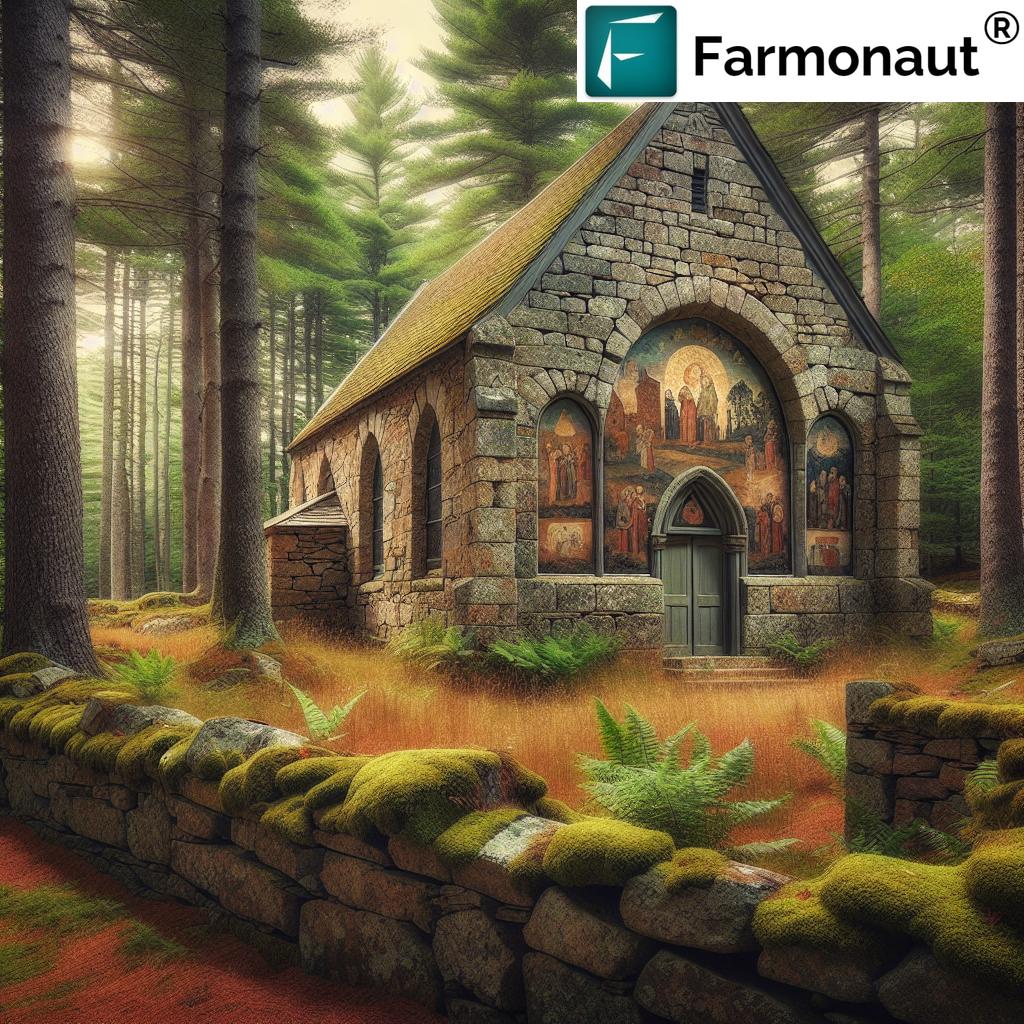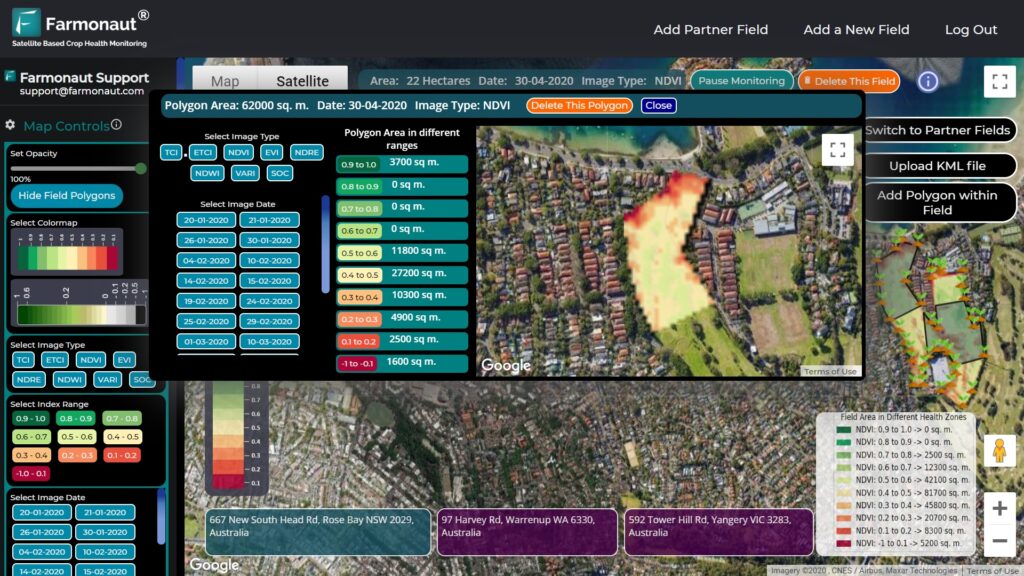Maine Historical Sites: Discover Hidden Art in Stone Wall Churches
“Over 50 stone wall churches in Maine feature hidden frescoes, blending art with New England architecture since the 1800s.”
Table of Contents
- Introduction
- The Essence of Maine Historical Sites
- Heritage of Stone Wall Structures in Maine
- South Solon Meeting House: Maine’s Hidden Treasure
- Hidden Art in New England Church Architecture
- The Local Community’s Role in Preserving Maine’s Gems
- Fresco Murals in Maine: Bridging Art & Heritage
- Comparative Feature Table: Maine’s Stone Wall Churches & Hidden Art
- Community Gathering Spaces and Events
- Preserving Heritage with Technology and Sustainability
- Explore Maine Historical Sites Today
- Farmonaut: Pioneering Agricultural Technology in Maine
- FAQs: Maine Historical Sites & Stone Wall Churches
- Conclusion: Maine’s Legacy of Art, Architecture & Community
Introduction: Unveiling Maine’s Historical Sites & Hidden Art
Maine is renowned for more than its breathtaking pine forest hills and sprawling agricultural landscapes; it also boasts an abundance of historical sites that tell stories of local communities, culture, resilience, and hidden artistry. Nestled within towns like Solon, stone wall churches appear simple from the outside, but step inside, and we often find ourselves in awe of intricate, century-old fresco murals—a remarkable blend of New England church architecture and local craftsmanship.
As we journey together to explore these Maine historical sites, we’ll focus on the gems waiting inside stone wall structures, particularly the South Solon Meeting House, lovingly called “Maine’s Sistine Chapel.” Alongside their architectural grace, these churches foster vibrant rural communities and contribute to the ongoing dialogue between art, nature, and innovation.
The Essence of Maine Historical Sites
At the meeting point of history, art, and nature, Maine historical sites invite us to rediscover New England’s enduring relationship with its landscape and people. From the hills and pine forests to the valleys enriched by agriculture and forestry, Maine’s stone wall churches are more than places of worship. They are community centers, art galleries, and living museums.
- Location & Setting: Often surrounded by pine forest hills, these church sites blend with the natural topography.
- Architecture: A signature New England look—boxy, white-washed structures with tall steeples and stone wall borders—distinguish them across rural Maine towns.
- Artistic Hidden Gems: Many feature 20th-century frescoes, painted by artists with ties to Maine’s vibrant art schools and local communities.
- Community Involvement: Over centuries, these sites have been preserved and repurposed by community efforts, evolving into community gathering spaces.
- Heritage Preservation: Their ongoing restoration is a testament to Maine’s commitment to art in historical buildings and local legacy.
The south of Maine, in particular regions such as Solon, exemplifies this unique blend of heritage and artistry. Here, amid the hills and forests, we find not only evidence of early European settlement but also modern-day rural community engagement.
“Maine’s pine forest hills house 30+ historic sites where local communities preserved unique church art for over a century.”
Stone Wall Structures in Maine: The Foundation of Art and Architecture
Stone wall structures are the backbone of many historical sites in Maine. Constructed primarily in the 19th century, these robust boundaries delineate sacred and communal space, showcase masterful masonry, and protect the sanctity of local church grounds. But their importance goes far beyond aesthetics.
Why Stone Walls?
- Abundant Local Materials: The glacial soil in New England, especially in regions like Solon and Waterville, yields stones with every planting season. Farmers and community members transformed these into functional, beautiful wall structures.
- Symbol of Community: Building a stone wall was often a communal task, with townspeople, farmers, and local faith communities working together.
- Endurance & Longevity: These stone walls have weathered the snowstorms, winds, and stories of more than a century—testaments to resilience, much like the communities they surround.
Today, stone wall structures in Maine still line the grounds of pine-shrouded churches, adding gravitas and historical weight to sites that are otherwise tucked away in quiet corners of the state.
South Solon Meeting House: Maine’s Hidden Treasure
When we speak of hidden gems in Maine towns, the South Solon Meeting House stands at the forefront. Tucked in Solon’s rolling pine forest hills, the church is emblematic of New England church architecture—from its single steeple to its classic white clapboard walls encircled by a historic stone wall. But stepping inside, we uncover the true treasures: vibrant fresco murals in Maine that have stunned visitors for over 70 years.
A Historical Overview
- Year Built: 1842
- Original Use: Religious services for the Solon community until the 1940s
- Disuse & Revival: By the mid-20th century, it had fallen idle. In 1951, Margaret Day Blake—an alumna of Skowhegan School of Painting and Sculpture—rallied artists to create a new legacy within its walls.
From 1952–1956, under the direction of the Skowhegan School, thirteen artists painted floor-to-ceiling frescoes, depicting biblical scenes, creative interpretations of faith, and references to greats like da Vinci and Michelangelo. These murals have since been called “Maine’s Sistine Chapel,” attracting visitors from across the state and beyond.
Art in Historical Buildings: The Secret Beauty of New England Church Architecture
It’s a wonder how many of us pass by unassuming churches in Maine towns, unaware of the cultural treasures hidden within. Inside these walls, art and architecture intermingle, offering a feast for the senses and soul.
Notable Artworks & Murals
- The Last Supper: Inspired by Leonardo da Vinci, one mural in South Solon Meeting House captures a reimagined rendition of the iconic meal.
- The Binding of Isaac: A hooded Abraham and his son, painted in somber colors, evoke intense emotion and artistry.
- The Great Flood: Michelangelo’s influence is clear in the mural’s dynamic energy and epic scale.
- Jacob Wrestling the Angel: Painted by Sigmund Abeles, it remains a testament to both religious narrative and artistic innovation.
Every brushstroke on these walls reflects not only personal faith but a communal desire to claim, preserve, and celebrate Maine’s unique place in America’s art history. These works continue to inspire visitors, educators, and the local art community alike.
Experience advanced farm management and precision agriculture with the Farmonaut platform.
The Local Community’s Role in Preserving Maine’s Gems
None of these beautifully preserved Maine historical sites would exist without the passionate support and vision of local communities. From maintenance and restoration to promoting rural town community events and art education, the community remains the lifeblood of these churches.
Community Initiatives:
- Local Historical Societies: Organizations—often staffed by art professors, teachers, and volunteers—coordinate preservation efforts.
- Education: Initiatives like those from Colby College students in Waterville help to catalog, study, and inspire renewed interest in frescoes and local art.
- Open Doors: Many of these churches, such as the South Solon Meeting House, are open to the public as gathering spaces, performance venues, and lecture halls.
- Art Teacher Engagement: Regional art educators introduce students to art in historical buildings, reinforcing the value of heritage and creativity.
By highlighting the broader engagement of community, these spaces have transformed from religious buildings to living centers for rural town community events and artistic exploration.
Fresco Murals in Maine: Bridging Art & Heritage
The fresco murals in Maine are more than just striking visual elements—they are bridges between past and future, heritage and innovation. Inspired by the world-renowned works of Italy, Maine artists and their mentors revolutionized the interiors of rural churches.
Features of Maine’s Fresco Murals
- Technique: True fresco (painting on wet plaster) ensures longevity and deep color saturation.
- Subjects: While biblical stories dominate, artists were given creative freedom, resulting in both traditional and avant-garde scenes.
- Legacy Artists: Sigmund Abeles and Sidney Hurwitz, both now in their nineties, recall their time in Solon as one of creative liberation and community.
- Public Access: Unlike works housed in major institutions, these frescoes remain part of the public domain—a point of pride for the local historical society.
Our exploration is as much about experiencing art as understanding its impact on community and continuity. As Maine’s art education advocates emphasize, these murals inspire not just visitors, but generations of students and teachers.
Comparative Feature Table: Maine’s Stone Wall Churches & Hidden Art
| Church Name | Location (Town/Region) | Year Built (Est.) | Architectural Style | Notable Frescoes/Artwork | Community Significance | Estimated Annual Visitors |
|---|---|---|---|---|---|---|
| South Solon Meeting House | Solon, Maine | 1842 | New England Church; Stone Wall Structure | 70-year-old full-interior fresco murals (“Last Supper,” “Binding of Isaac”) | Community gathering space; lectures; art education hub | 3,000+ |
| St. John’s Catholic Church | Bangor, Maine | 1835 | Gothic Revival with stone walls | Wall paintings of saints, intricate stained glass | Annual festivals, charity events | 5,500+ |
| First Parish UU Church | Portland, Maine | 1825 | Colonial; stone wall boundary | Restored 19th-century ceiling murals | Civic events; music concerts | 6,000+ |
| St. Patrick’s Church | Newcastle, Maine | 1807 | Federal-era with stone wall | Hand-painted altars, woodwork | Oldest Catholic church in New England; tours | 4,500+ |
Community Gathering Spaces in Maine: Rooted in History & Art
In Maine, stone wall churches extend far beyond their walls as spaces for worship. Today, many serve as vital community gathering spaces in Maine—hosting everything from art lectures and exhibitions to music concerts and civic forums.
Rural Town Community Events
- Seasonal Festivals: These events connect farming cycles, the local food movement, and small-town spirit.
- Art Exhibitions: Residents and tourists alike are invited to experience local talent alongside works of historical significance.
- Workshops: Local artists, teachers, and historians lead hands-on sessions about fresco painting, stone wall restoration, and Maine’s art traditions.
- Pine Forest Walks: Many gatherings incorporate walks through the pine forest hills of Maine, offering a holistic experience of nature and history.
These experiences nurture Maine’s well-known sense of community and ensure a bright future for the preservation of hidden gems in Maine towns.
Explore Farmonaut’s blockchain-based traceability solution, boosting transparency in Maine’s agricultural supply chains and ensuring consumer trust in local produce.
Preserving Maine’s Heritage with Technology and Sustainability
Modern challenges, be it rural depopulation, climate change, or shifts in community finance, threaten the legacy of Maine’s historical church sites. Yet innovation and technology offer new hope in their preservation and sustainable integration with contemporary life.
Key Pathways for Preservation
-
Environmental Stewardship:
Solutions like Farmonaut’s carbon footprinting tools support local agriculture and forestry groups in tracking real-time emissions, promoting practices that protect historical sites and their surrounding forests. -
Financial Accessibility:
Accessible funding through crop insurance and farm loans, such as those enabled by satellite-based verification solutions, empower landowners and non-profits to maintain sites while ensuring continued agricultural productivity. -
Large-Scale Farm Management and Advisory:
By integrating satellite monitoring and AI-driven advisory systems like Farmonaut’s Agro Admin App, both private and community-owned forests and farms can optimize resource use while safeguarding the historic landscape. -
API for Integration:
Researchers, developers, and local government agencies can harness Farmonaut’s API & Developer Docs to integrate real-time satellite and weather data, improving decision-making for sustainable heritage management.
Sustainability in Maine now means the intersection of tradition with the effectiveness of emerging technologies.
For tailored guidance on preserving forests, community lands, and agricultural sites, try the Farmonaut crop plantation and forest advisory tools—built for proactive and sustainable local stewardship.
Explore Maine Historical Sites Today
With growing digital access, interactive exhibits, and newly launched websites dedicated to sites like the South Solon Meeting House, it has never been easier to start planning a journey through rural Maine. Here’s how anyone can join the new wave of heritage explorers:
Step-by-Step Exploration
- Research: Tap into local town websites and organizations like Colby College for schedules, virtual tours, and art education resources.
- Visit in Person: Experience the tactile beauty of Maine’s stone wall structures, pine forest hills, and their vibrant mural interiors.
- Engage & Share: Join lectures, workshops, or community events. Share your journey on social platforms to raise awareness for local preservation.
- Support: Consider donating to community restoration efforts or volunteering with local historical societies.
Connect your farms with Farmonaut—satellite-based crop monitoring, real-time advisory, and more for everyone in Maine.
Farmonaut: Pioneering Agricultural Technology for Maine’s Land & Heritage
In Maine, where agriculture, forestry, and heritage conservation go hand-in-hand, Farmonaut delivers cutting-edge technology tailored for rural and community-scale users. By offering a powerful but affordable platform for farm management and environmental monitoring, Farmonaut empowers both farmers and historical societies. Here’s how:
Advanced Tools for Maine’s Unique Landscape
- Satellite-Based Crop Health Monitoring: Get insights into soil health, crop moisture, and pest risks across fields, from the hills of Solon to the valleys of Waterville.
- Blockchain-Based Traceability: Ensure total transparency for Maine’s agricultural and forest products with immutable records benefitting both producers and consumers.
- AI Advisory Systems: Receive data-driven suggestions for optimal irrigation, pest, and disease control—vital for sustainable farming and maintaining open spaces around historical sites.
- Carbon Footprinting: Track real-time carbon emissions for sustainable forestry and farm operations, helping to preserve soil quality and reduce environmental impact.
- Resource Management: Manage agricultural fleet, optimize logistics, and ensure responsible use of technology with Farmonaut’s fleet management tools.
Whether you are an individual farmer, a Maine historical society, or a local NGO, Farmonaut’s platform suits diverse needs—from rancher resource planning to community garden monitoring.
FAQs: Maine Historical Sites & Stone Wall Churches
What makes Maine historical sites unique?
Our state’s heritage lies in the fusion of New England church architecture, local art, and preserved rural traditions. Stone wall structures, pine forest surroundings, and hidden art murals are defining characteristics.
How can I experience fresco murals in Maine?
Visit churches like the South Solon Meeting House, join guided tours, attend art education events in Waterville, or browse interactive digital exhibits online.
Are these sites still used for religious services?
Many are now community gathering spaces in Maine, hosting events, performances, and educational programs while sometimes maintaining religious activities.
Can I support preservation efforts?
Absolutely. Volunteer, donate, or help raise awareness for your local town’s historical society. Supporting sustainable practices in forestry and agriculture also protects these sacred places.
Is modern technology used at these sites?
Leading organizations increasingly use satellite agriculture tools (like those from Farmonaut), blockchain traceability, and carbon tracking to responsibly manage landscapes and ensure the legacy of Maine’s treasures.
Conclusion: Maine’s Legacy of Art, Architecture & Community
As we conclude our exploration of Maine historical sites, it becomes clear that the power of these places lies not only in their stone wall structures and fresco murals but also in the enduring spirit of community that preserves them. Rooted in New England church architecture, nestled among pine forest hills, and reflecting the best in art in historical buildings, these hidden gems are Maine’s gifts to both locals and visitors.
Our state’s true heritage is the interconnected relationship between people, land, art, and technology—a living legacy ready for you to discover in every rural town and rolling hill.
Ready to be part of Maine’s ongoing story? Start planning your visit, champion local preservation, and experience the wonder of these one-of-a-kind sites today!
Unlock the power of satellite-driven farm insights—try Farmonaut on Web, Android, or iOS today.














